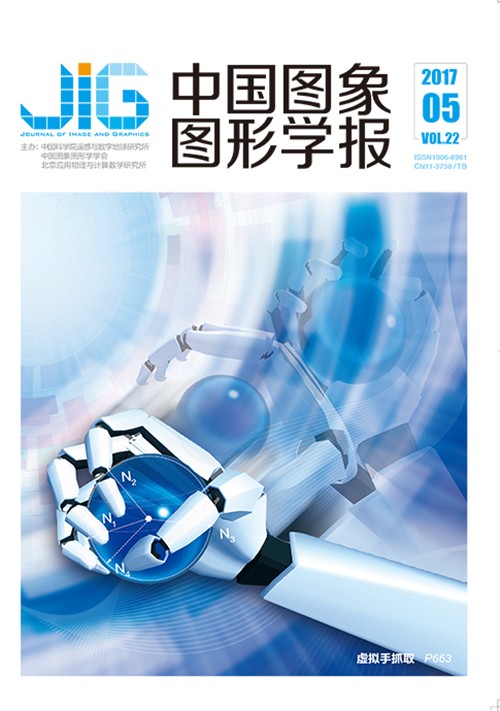
虚拟结肠镜中皱襞预匹配的结肠配准
郭志飞1,2, 段侪杰1,2, 梁正荣3(1.深圳市无损和微创医疗技术重点实验室, 清华大学深圳研究生院, 深圳 518055;2.清华大学生物医学工程系, 北京 100084;3.美国纽约州立大学石溪分校放射学系, 纽约 11790) 摘 要
目的 虚拟结肠镜是一种采用CT或者MRI图像重建出结肠3维结构,通过漫游虚拟结肠来检测结肠组织,一般用于早期结直肠癌筛查。结肠配准能够有效提高息肉检测的效率和精确度,但由于仰卧和俯卧位下的结肠图像形变太大,现有的配准方案中特征点的提取没有考虑到较多特殊情况,因此需要寻找一个新的配准方案完成完整的结肠配准。方法 提出了一种新的结肠图像配准方法,能够完成不同体位获取的虚拟结肠图像之间的配准。首先提取可以反映结肠结构信息的皱襞特征,用模板匹配和特征匹配方法找出两幅结肠中匹配的皱襞对。然后将匹配对的中心点作为标记点,做基于标记点的非刚性粗配准,最后将两幅图做B样条配准完成细配准。这种方法能够将结肠内部较大的形变先矫正,使得两幅图之间的形变缩小到一定范围,然后利用传统配准方法能够完成配准。结果 在5套数据中,找到能够成功匹配的皱襞区域数量占所有分割出的皱襞区域总数量的62%左右,匹配错误率为4.7%左右。完成皱襞粗配准后,结肠形变明显趋于一致,灰度值相对误差减小,最终完成了结肠配准。结论 先进行皱襞匹配再做基于匹配好的皱襞的映射关系做结肠配准,能够将存在较大形变的两套结肠匹配起来。在之后的工作中需要量化特征点选取对配准结果的影响,同时在做配准评估时,单纯采用灰度差值不能很好完成评估,因为灰度特征只能一定程度反映整体差异,不能很好体现结构差异,需要添加其他评估标准辅助配准评估。
关键词
Colon images registration based on the pre-match of haustral folds
Guo Zhifei1,2, Duan Chaijie1,2, Liang Zhengrong3(1.Shenzhen Key Laboratory for Nondestructive and Minimal Invasive Medical Technologies, Graduate School at Shenzhen, Tsinghua University, Shenzhen 518055, China;2.Department of Biomedical Engineering, Tsinghua University, Beijing 100084, China;3.Department of Radiology, Stony Brook University, Stony Brook, New York 11790, USA) Abstract
Objective Virtual colonoscopy is a method that scans through the 3D structure of a colon constructed by CT or MRI images and detects colon tissue, specifically, the polypus, which has great significance for early colorectal cancer screening. Registering colon images that have been acquired with different body positions can greatly improve the efficiency and accuracy of polyp detection in virtual colonoscopy. However, the traditional registration cannot accomplish this goal because of the drastic change in the supine and prone position of the patient, and the extraction of the feature points in the existing registration scheme does not take into account more special cases. Therefore, finding a new registration scheme of colon image is crucial. Method In this paper, a new method of colon registration that can complete the image registration acquired in different positions is proposed. Many previous works gradually flatten the three-dimensional (3D) colon to two-dimensional (2D) coordinates because of the large volume of 3D colon data. Registering 2D colon image directly is more convenient and easy to use for clinical application. Substantial work has been done to extract the effective feature points of the two images in registration. However, feature points acquired with previous methods cannot fully reflect the structural characteristics of the colon images obtained in different body positions, particularly the correlation between the two images. Haustral folds are remarkable and distributed in the entire colon; these folds are stable while the patient switches position. Therefore, the corresponding center of the fold can fully reflect the structural characteristics of the colon and is very suitable for colon registration. This paper proposes a new method to match the folds the two colon images and extract the center of matched folds as the feature point for registration. The complete registration scheme is as follows. First, extract the haustral fold that can reflect the information of fold structure. Gather the matched haustral folds using the method of template matching and feature matching and extract the center of matched folds as the feature points for image registration. Subsequently, do the non-rigid registration based in the center of matched haustral folds as coarse registration. The deformation between the two images is reduced in a more appropriate range after coarse registration. Finally, use b-spline registration based on gray value to complete the fine registration of the two pictures. This method can retrieve the drastic change in the colon image and make the change of the two images within certain limits. The traditional registration method can also be used as the feature point registration in previous works. Result Specific trained people can find out the two sets of matching colon folds because of the fold is remarkable in the colon. In the five sets of clinical data, about 62% haustral folds can be matched in comparison with the results of artificial matching. The rate of matching error is 4.7% because the center of matched folds is a significant feature point with high confidence in the two colon images and is very stable when patients switch position from supine to prone. The center of matched folds is more illustrative than other structural feature points in colon registration. The colonic deformation decreases after the rough registration of the folds, which makes the two colon images be registered using the traditional registration method. We accomplished the registration of colon images by using b-spline registration based on coarse registration. After registration, the gray absolute difference between the two colon images is clearly reduced. The set of colons that matches the high ratio of folds has the best registration accuracy. The gray value of the folds will have some differences because of the different angles of color rendering, and the absolute difference of gray image will still have a certain value after image registration. However, gray-scale difference can only reflect the global difference between the two colon images, but the structural features of the colon cannot be well evaluated. Therefore, the difference of polyp location detected by clinicians will be added to improve the evaluation method in the future. Conclusion A new colon registration scheme is proposed in this paper. The drastic deformation between colon images caused by colon displacement and colon leakage makes the registration environment more complex and the previous feature points acquired unable to work well. Compared with the feature points using the previous method, the center of matched folds used as feature points can characterize the colon structure more significantly. The deformation of two colon images can be corrected when performing the rough registration of two colon images. We also completed fine registration using b-spline registration method based on coarse registration. In the present work, selecting the central points of the matched folds is still a more subjective process. Using all the center points may cause over registration and using less center points may also cause under-registration. Moreover, there will be more quantitative work on the final selection of feature points. However, the assessment cannot be completed simply using the difference of gray scale when performing registration evaluation. Therefore, others should be selected as criteria to improve the results of registration evaluation.
Keywords
|



 中国图象图形学报 │ 京ICP备05080539号-4 │ 本系统由
中国图象图形学报 │ 京ICP备05080539号-4 │ 本系统由